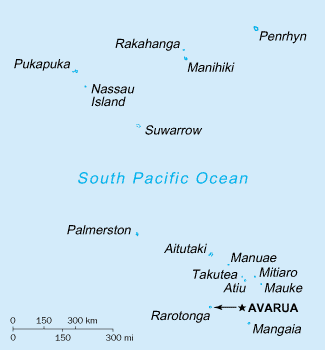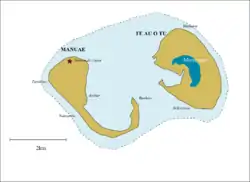Manuae (Cook Islands)
Manuae is an uninhabited atoll in the southern group of the Cook Islands, 100 kilometres south-east of Aitutaki. It is administratively part of Aitutaki, but it does not belong to any district or tapere of Aitutaki. It is, however, part of Arutanga-Reureu-Nikaupara Constituency.
_Aerial.jpg.webp) An aerial view of Manuae | |
 | |
| Geography | |
|---|---|
| Area | 6.17 km2 (2.38 sq mi) |
| Highest elevation | 5 m (16 ft) |
| Administration | |
| Demographics | |
| Population | 0 (2006) |
Geographic description

Manuae is a true atoll sitting on the peak of a submerged volcano which descends over 4000 meters to the ocean bed. It comprises two horseshoe-shaped islets, Manuae to the west and Te Au O Tu to the east, with a total area of 6 km2[1] on either side of a lagoon about 7 km x 4 km. Manuae has an area of 2.1 km2, while Te Au O Tu's is 3.9 km2.[2] The lagoon is 13 km2 in size, shallow and subject to large shifting sand banks.[3] A coral reef surrounds the atoll, and there is no passage through the reef.[4]
The island is a marine park and is an important breeding ground for seabirds and marine turtles in the Central Pacific. The offshore waters of Manuae are good fishing grounds.
History
Captain James Cook sighted Manuae on 23 September 1773, the first of the Cook Islands he voyaged to. Initially he named it Sandwich Island but changed it to Hervey Island in honor of Augustus Hervey, 3rd Earl of Bristol, then a Lord of the Admiralty. Capt. Cook later decided to give the name of "Sandwich Islands" to the Hawaiian Islands instead. This name was later corrupted to Hervey's Island, or Hervey's Isle, and later applied to the entire southern group, as the Hervey Islands. This name remained popular until 1824 when the islands were renamed the Cook Islands by the Russian cartographer von Krusenstern, in honor of Capt. Cook who had died in 1779.
In April/May 1965 the population briefly increased to 120 when the island was visited by six expeditions (from Australia, N.Z., Japan, U.K., U.S.A. and U.S.S.R.) to observe the total solar eclipse of 30 May 1965.
Norwegian author Erlend Loe writes humorously about an expedition to Manuae in his 1999 novel "L".
In April 2020 the Cook Islands National Environment Service advertised for two caretakers to live on the island for a year.[5]
Economy and improvements
The island once supported a small copra industry with a settlement established next to the small reef passage less than one kilometer northeast of Turakino, the westernmost point of the atoll. The passage, at the sea entrance, is less than 4 metres wide and in a swell is exceedingly dangerous without local knowledge.
The island has an airfield (a dirt airstrip barely visible) that has been out of use for several years. Fishermen from Aitutaki occasionally organise trips to Manuae. All regulations applicable to Aitutaki, apply to Manuae as well.[3]
Demography
The population peaked with 32 at the 1956 census, but twenty years later the island was abandoned.
|
| |||||||||||||||||||||||||||
| Papers Past[6] | ||||||||||||||||||||||||||||
See also
- Desert island
- List of islands
References
- Alphons M.J. Kloosterman (1976). Discoverers of the Cook Islands and the Names they Gave. Cook Islands Library and Museum. p. 21. Retrieved 29 July 2020.
- A. H. McLintock, ed. (1966). "ISLAND TERRITORIES: COOK ISLANDS". Retrieved 29 July 2020 – via Te Ara - the Encyclopedia of New Zealand.
- "Basic Information on the Marine Resources of the Cook Islands" (PDF). Ministry of Marine Resources. p. 37. Archived from the original (PDF) on 26 February 2012. Retrieved 16 August 2008.
- "SECTOR 2: THE LINE ISLANDS, THE COOK ISLANDS, THE SAMOA ISLANDS, AND THE TONGA ISLANDS (INCLUDING OFF-LYING ISLANDS AND REEFS)". Sailing Directions (enroute) for the Pacific Islands (PDF). Defense Mapping Agency, Hydrographic/Topographic Center. 2002. p. 50. Archived from the original (PDF) on 25 October 2004.
- "'Best job in world' advertised in Cook Islands". RNZ. 7 April 2020. Retrieved 29 July 2020.
- "COOK ISLANDS - Lower Group Census". Evening Post. 28 May 1936. p. 10. Retrieved 29 July 2020 – via National Library of New Zealand.